
Where are the coldest cities in the US? If you guessed Alaska, you wouldn’t be alone. As the country’s northernmost state by far, the cities in Alaska dominate the list of coldest places in the US. To explore some of the nation’s other cool spots, we’ve only ranked cities with a population of at least 25,000. That will give the lower 48 at least a fighting chance!
To compile this list, we looked at average annual temperatures for each city over a thirty-year period rather than the minimum temperature ever experienced. That’s because we wanted to see who gets cold consistently, or perhaps never really warms up in the summer, rather than who had the misfortune of being at the center of a major cold snap.
What are the Coldest Cities in the United States?
Let’s take a look at the coldest cities in the US (with a population over 25,000) according to average annual temperature data from NOAA’s National Centers for Environmental Information (NCEI).
1. Fairbanks, Alaska
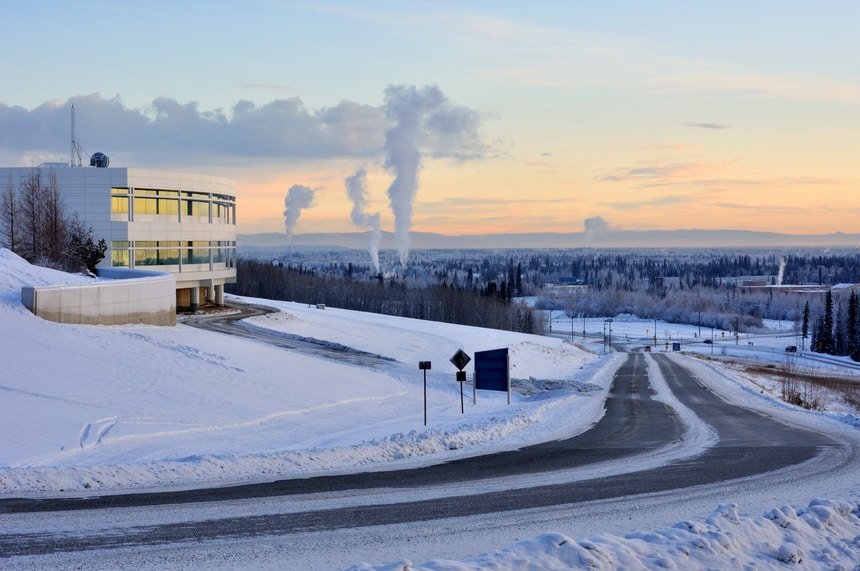
- Average Annual Temperature: 27.6°F
- Average Annual Number of 32°F or Lower Days: 225
- Record Lowest Temperature: -66°F on January 14, 1934
Fairbanks, Alaska, is the coldest city in the United States, with an annual average temperature of 27.6°F, which is safely below freezing, unlike any other city on the list. Additionally, there are three months (December, January, and February) where its average temperature is less than 0°F. January is the coldest month in Fairbanks, with an average temperature of -7.9°F.
Fairbanks has two significant advantages over any other major US city regarding the cold: its latitude and distance from the ocean. Located at almost 65 degrees latitude, Fairbanks is the northernmost US city with a population above 25,000. That alone puts it in a solid lead. But it’s significantly colder than other cities in Alaska because it’s several hundred miles from the ocean’s moderating influence, unlike Anchorage or Juneau.
Coastal weather tends to be more moderate because the ocean slowly cools in the winter, keeping the air warm. While in the summer, it slowly warms, keeping the air cool.
During the long polar nights, heat radiates away from Fairbanks for much of the day, and the low sun angle means that very little additional energy reaches the ground when the sun is up. Lots of heat energy going out into space and very little coming back means that Fairbanks is the perfect place to grow a cold air mass.
Does all this cold translate into snow? Sometimes! Fairbanks records 64.8 inches of snow on average each year, more than most major US cities. It doesn’t make our list of snowiest cities, though. That’s because, for much of the winter, it’s actually too cold for snow! How is that possible? Cold air can’t hold as much moisture as warm air, and you need moisture for snow. If it’s too cold and too dry, no flakes can fly. That’s why the snowiest months in Fairbanks are November and December. It’s cold enough for snow early in the winter but not yet too cold and too dry. While Fairbanks doesn’t produce much precipitation, it has plenty of foggy days, making it one of the cloudiest cities in the US.
In the summer, Fairbanks also gets reasonably warm thanks to its distance from the ocean. Its warmest month is July, with an average temperature of 62.5°F. Quite pleasant!
2. Anchorage, Alaska

- Average Annual Temperature: 37.0°F
- Average Annual Number of 32°F or Lower Days: 191
- Record Lowest Temperature: -38°F on February 3, 1947
Despite being right on the coast, Anchorage rides its latitudinal advantage straight into spot number two. Its winters aren’t known for being bitterly cold. While it certainly can get chilly for a few days at a time, its coldest month (January) has an average temperature of 17.1°F. That’s warmer than most of the other cities on the list!
However, what Anchorage lacks in the top-tier winter cold, it more than makes up for it with the lack of winter warmth. Its warmest month, July, has an average temperature of only 58.8°F. That’s because the icy waters of the Gulf of Alaska are right nearby, always ready to help provide a cooling influence if the air gets too warm.
3. Duluth, Minnesota
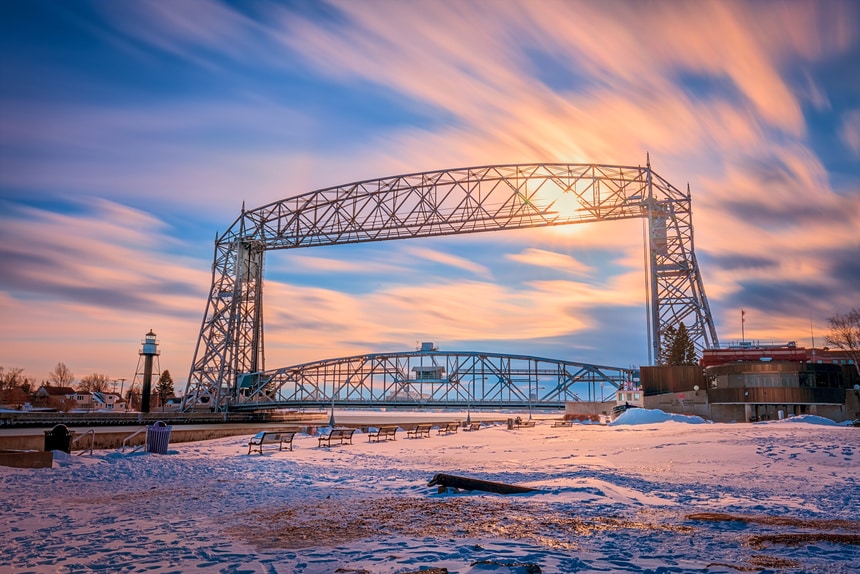
- Average Annual Temperature: 39.6°F
- Average Annual Number of 32°F or Lower Days: 183
- Record Lowest Temperature: -39°F on February 2, 1996
Duluth takes the number three spot on our list, but it is the coldest city in the lower 48 states. Its winters aren’t frigid, but they are colder than Anchorage’s! Duluth’s coldest month is January when the temperature averages 10.2°F.
Located on the southwesternmost tip of Lake Superior, the largest of the Great Lakes, Duluth somewhat splits the difference between maritime cities and those well inland. Lake Superior can and often does freeze during the winter, which means it’s no longer a warming influence during the coldest time of the year. Instead, large quantities of ice nearby can actually make things cooler than if forests surrounded you.
Winters in Duluth aren’t just cold they’re also quite snowy! Duluth averages 83.5 inches of snowfall each winter, making it the seventh-snowiest city in the United States! Duluth also has Lake Superior to thank for the snow, a substantial portion of which comes from the process of lake effect, where cold air passing over warm water generates prolific snow.
Then in the spring and summer, all that slow-melting ice and the frigid water it generates can keep things cool, just like along the Atlantic and Pacific coasts. Duluth’s warmest month is July when the temperature reaches a pleasant 65.8°F on average.
4. Grand Forks, North Dakota
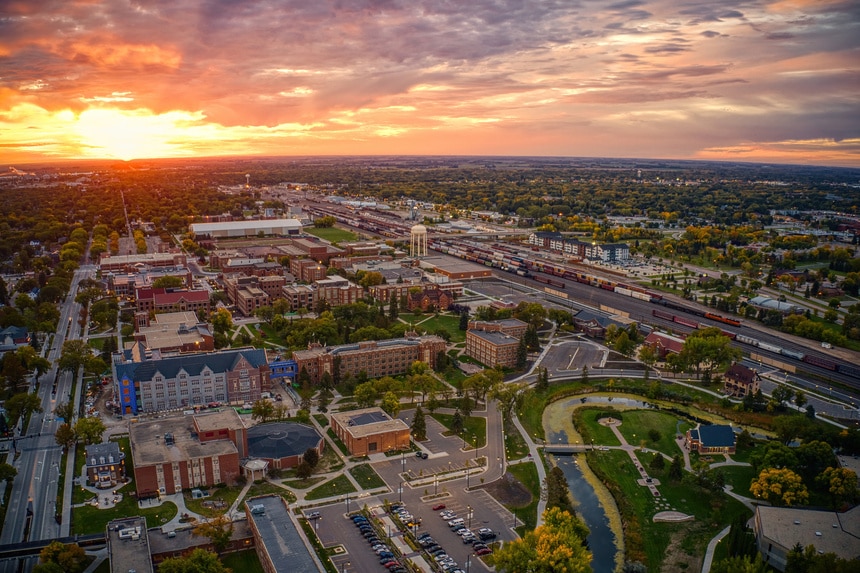
- Average Annual Temperature: 39.8 °F
- Average Annual Number of 32°F or Lower Days: 186
- Record Lowest Temperature: -43 °F on January 11, 1912
Grand Forks, North Dakota, earns a spot on the list as it is positioned squarely in the sights of Arctic air masses when they first cross over from Canada. Arctic air masses (blobs of air known for being extremely cold and dry) build up over places like Fairbanks, Alaska, during the winter when days are short and nights are long in the high latitudes. Sometimes, these blobs of frigid air get dislodged from their birthplace and begin heading south.
The most common path for air masses like this to follow in North America begins up in Alaska and the vast Canadian Yukon Territories, down the eastern slope of the Rockies into the Great Plains of the United States. This means Grand Forks is among the first in line for bitter cold in the winter. That’s helpful because every day that an Arctic air mass spends in the lower latitudes, it loses some of its punch thanks to the greater amount of sunshine we get down here (at least compared to northern Canada in winter!).
The coldest month in Grand Forks is January, with an average temperature of 6.7°F. That’s colder than any other city except Fairbanks! In the summer, Grand Forks can be warm—even hot—because it’s located far from any water source big enough to provide a cooling influence. July is Grand Forks’ warmest month, with an average temperature of 68.6°F.
5. Williston, North Dakota
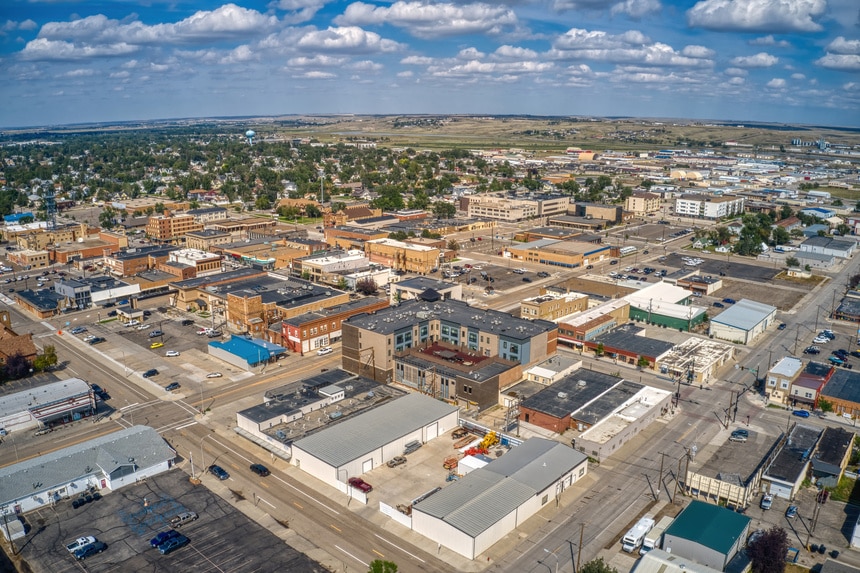
- Average Annual Temperature: 41.5°F
- Average Annual Number of 32°F or Lower Days: 186
- Record Lowest Temperature: -50°F on February 16, 1936
Williston, North Dakota, sits near the state’s northwestern corner, just east of the border with Montana. Much like Grand Forks, it is first in line to experience bitter cold air masses moving down from Canada in the winter. Along with much of the Northern Plains, Williston gets the dubious distinction of enjoying these air masses before they can moderate in the lower latitudes. That helps Williston notch an average January temperature of just 11.0°F.
Why is Williston’s January temperature so much higher, by nearly 5°F, than Grand Forks, when Grand Forks is at a lower elevation farther south? The answer lies 430 miles west of the town where the Rocky Mountains soar above the prairie. Wind descending the mountains warms as it loses elevation. If you get strong westerly winds, which can often happen in winter, it will create a warm air mass using just the mountains. Williston is closer to the source of this warm air than Grand Forks, so it has a higher average temperature.
6. Juneau, Alaska
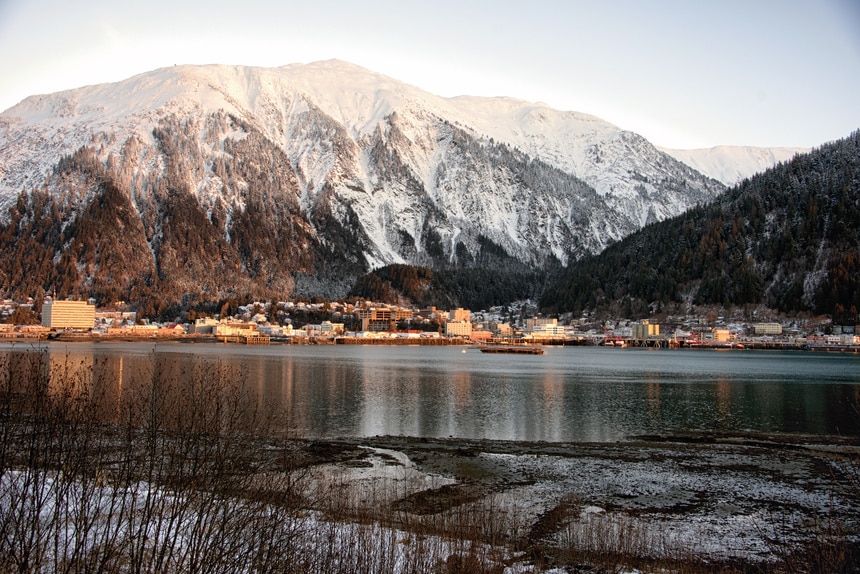
- Average Annual Temperature: 42.1°F
- Average Annual Number of 32°F or Lower Days: 136
- Record Lowest Temperature: -22°F on January 12, 1972
Juneau is very similar to Anchorage in its climate. It’s right on Alaska’s chilly, gloomy coast. So while Juneau isn’t brutally cold in the winter (its coldest month, January, has an average temperature of 28.3°F—the highest average January temperature of any city on the list), it never really heats up during the summer. July, Juneau’s warmest month, sees an average temperature of just 56.9°F—the coldest July temperature of any city on the list.
Both of those statistics directly result from Juneau’s close proximity to water. Like Anchorage, Juneau is very close to the frigid Gulf of Alaska. However, Juneau is unique because it is also located near several large glaciers that provide extra cooling help during the summer.
Being close to the ocean also helps Juneau concoct uniquely dreary winters filled with clouds that often drop rain and snow. Juneau is the second snowiest city in the United States, with 93.6 inches falling on average annually. It’s also the second rainiest city in the United States, with 224 days on average of precipitation each year. That’s a lot of precipitation, most of it falling when it’s quite chilly!
7. Fargo, North Dakota

- Average Annual Temperature: 42.3°F
- Average Annual Number of 32°F or Lower Days: 177
- Record Lowest Temperature: -39°F on February 1, 1996
Fargo is similar to Grand Forks in that it is a prime candidate for first dibs on Arctic air surging south from Canada. Located just 75 miles south of Grand Forks, Fargo shares almost all of Grand Forks’ climatic attributes. However, it’s just a touch farther south, so, on average, Fargo isn’t quite as cold. Fargo’s coldest month is January, with an average temperature of 9.3°F, while July is warmest, with an average temperature of 71.0°F.
Fargo also happens to be the capital of what’s known as “Blizzard Alley:” a strip of land from western South Dakota to Minnesota that records blizzard conditions most frequently among lowland stations in the US. Why are blizzards most common here? It’s often cold, as we have learned! That allows snow to fall and collect on the ground without trouble. The land is also generally flat and open, free of obstructions, so snow can blow around and more effectively reduce visibility. You can find more information about blizzards here and how they form.
8. Bismarck, North Dakota
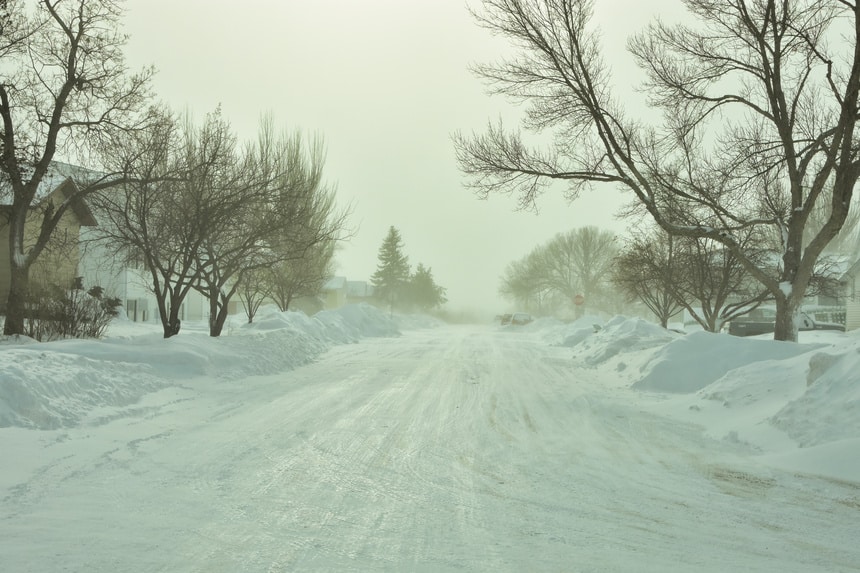
- Average Annual Temperature: 42.8°F
- Average Annual Number of 32°F or Lower Days: 186
- Record Lowest Temperature: -46°F on February 16, 1936
Located 185 miles due west of Fargo and 175 miles west-southwest of Grand Forks, Bismarck is similarly well-suited to bitter cold in the winter. North Dakota’s coldest air comes from the north or northwest, and all parts of the state can cash in on bitter temperatures.
When winds shift around to the west, though, the Rocky Mountains can exert a warming influence, especially on western parts of the state. That’s because winds blowing downhill get warmer as they go. The closer you are to the source of the warm air, in this case, the mountains, the warmer you’ll be, just like we talked about for Williston. That’s why Bismarck falls below Fargo and Grand Forks in the rankings! Bismarck’s coldest month, January, has an average temperature of 12.8°F, while its warmest month, July, has an average temperature of 71.1°F.
9. St. Cloud, Minnesota

- Average Annual Temperature: 42.8°F
- Average Annual Number of 32°F or Lower Days: 176
- Record Lowest Temperature: -43°F on January 9, 1977
St. Cloud, Minnesota, is located just northwest of Minneapolis in the central part of the state. Much like North Dakota, Minnesota is close enough to Canada to experience the bitter cold air from the north during winter. But unlike Duluth, St. Cloud doesn’t have a large, nearby source of cold water to provide a moderating influence during the summer. As a result, while its January low temperature of 11.6°F is similar to that of Duluth, its July high temperature is a bit warmer at 70.3°F (vs. 65.8°F for Duluth), helping push St. Cloud a bit farther down the rankings.
Saint Cloud’s distance from Lake Superior is also apparent when looking at its snowfall patterns relative to Duluth. While Duluth records 83.5 inches of snow each year, putting it near the top of our snowiest US cities list, Saint Cloud only gets 45 inches yearly despite being not so far away. Why is that? It’s all about Lake Superior, which strongly influences Duluth’s climate in more ways than one, while Saint Cloud is left high and dry just a few dozen miles southwest.
10. Aberdeen, South Dakota
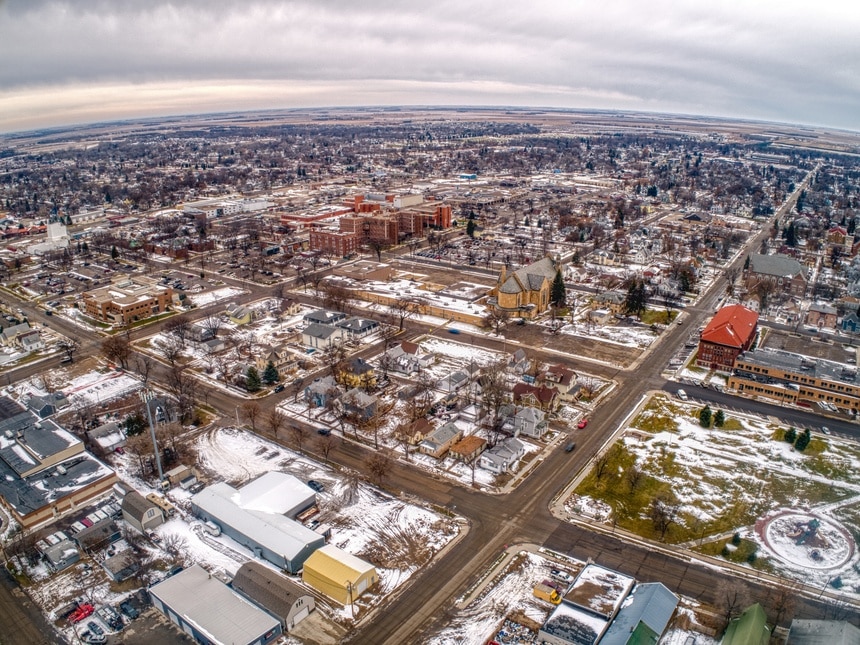
- Average Annual Temperature: 42.9°F
- Average Annual Number of 32°F or Lower Days: 178
- Record Lowest Temperature: -46°F on January 12, 1912
Another entry from the Northern Plains, Aberdeen, takes the number ten spot, primarily thanks to how cold it can get in the winter. Its average temperature in January is 12.0°F, similar to nearby Fargo and Bismarck. In the summer, though, Aberdeen can get plenty warm. Its July average temperature is 71.3°F, the warmest of any city on the list. Like Fargo, Bismarck, and other towns on the Plains, Aberdeen is regularly rocked by intense blizzards during the winter, which can help make a brutally cold air mass feel even more frigid.
11. Kalispell, Montana
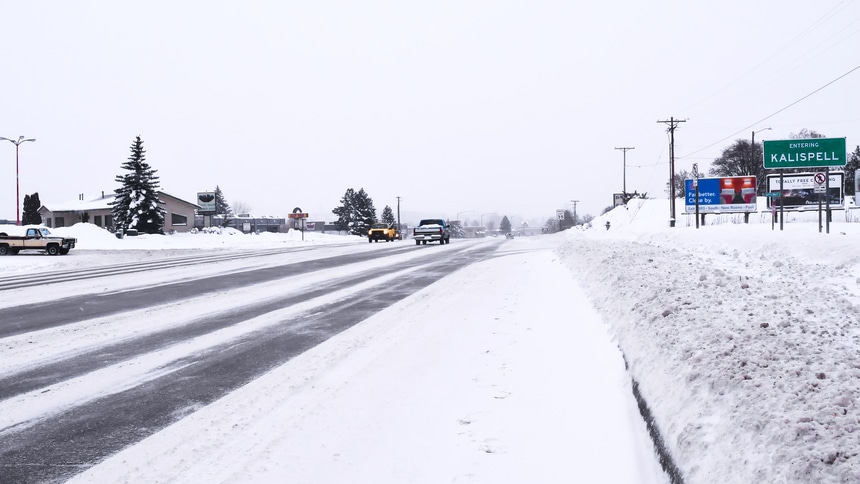
- Average Annual Temperature: 43.3°F
- Average Annual Number of 32°F or Lower Days: 178
- Record Lowest Temperature: -38°F on January 31, 1950
Our first and only entry from the Rocky Mountains is Kalispell, Montana, which is located in the far northwestern part of the state north of Missoula. Unlike any other cities we’ve talked about, Kalispell is nestled deep in the heart of the mountains. That makes getting bitter cold in the winter a little trickier. Arctic air masses moving south from Alaska, which have a smooth path to North Dakota, get blocked by the Flathead Mountains north and northeast of Kalispell.
It can still get cold, but this helps explain why Kalispell has one of the warmest winter average temperatures of any city on the list. Unlike any other city on the list, December is actually the coldest month in Kalispell, with an average temperature of 22.7°F.
Why does that happen? The answer lies in the Pacific Ocean, located a little under five hundred miles west of Kalispell. Strong westerly winds can push warm Pacific air into the Montana mountains. Westerly winds are typically strongest when the temperature difference between the North Pole and the Equator is largest. That usually happens in January and February after the North Pole has had a bit more time to cool off. So, long nights, short days, and proximity to Canada help Kalispell get cold in December, but by January, the strengthening westerly winds from the Pacific make the cold an uphill battle in western Montana. That’s not to say cold weather can’t happen. After all, Kalispell’s record low temperature of -38°F occurred at the end of January in 1950!
With such modest winters, you may wonder how Kalispell earns a spot in the top eleven. The answer comes in the summer when its higher elevation in the mountains helps the town avoid the scorching heat that can roast the Plains farther east. Its warmest month, July, has an average temperature of 64.7°F—cooler than every other city on the list outside of Alaska!
The Coldest Place in the USA
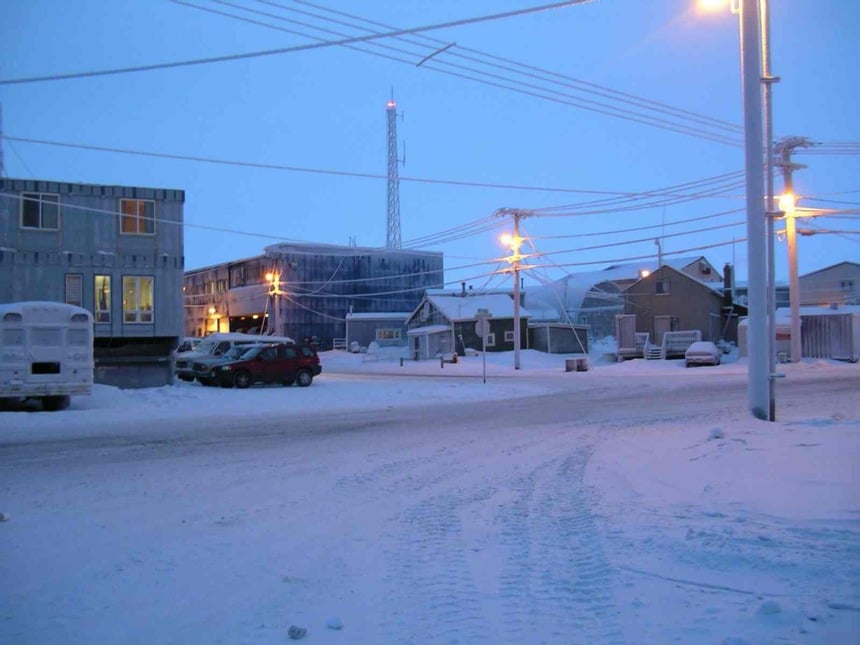
Utqiagvik, (formerly known as Barrow) Alaska is the coldest place in the United States, with an average annual temperature of just 11.7°F. But it doesn’t meet our population cut-off to earn a spot on our list. Amazingly, 4,927 people are tough enough to withstand its long, frigid winters and short, cool summers to call Utqiagvik home. It’s one of the coldest places on earth where humans live.
Utqiagvik is one of the only places in the United States to experience true polar nights when the sun doesn’t rise at all for over sixty days in late November, December, January, and early February. Combined with its proximity to the Arctic Ocean, frequently covered in ice, this is a nearly-perfect setup for cold weather.
In winter, on average, Utqiagvik spends four months below 0°F (December, January, February, and March). Its coldest month is February, with an average temperature of -14.2°F. While the summer only records three months with an average temperature above freezing (June, July, and August). Its warmest month, July, gets up to only 40.9°F.
What Is the Coldest Temperature Ever Recorded in the US?
Unsurprisingly, interior Alaska holds the record for the coldest temperature ever observed in the United States. On the morning of January 21, 1971, a weather observer in Prospect Creek Camp deep in the Alaskan wilderness checked his thermometer to see that it read a bone-chilling -80°F. By that afternoon, the temperature had only warmed to -64°F!
Final Thoughts
The coldest places in the United States are either in Alaska or the Northern Plains of North Dakota, South Dakota, and Minnesota. Up in Alaska, long polar nights and proximity to frigid North Pacific ocean waters help keep temperatures down. In the Northern Plains, proximity to bitter Arctic air masses during the winter compensates for the warmer summers to keep the annual average temperature down.
To earn a spot on the list of the top eleven coldest cities in America, you generally need to be in one of these areas. However, Kalispell snuck onto the list thanks to its high elevation in the northern mountains of Montana. If you’re looking to enjoy either bitterly cold winter temperatures or to escape the stifling heat of summer, the destinations on this list could be the right fit for you!
This list is compiled using data from the National Centers for Environmental Information’s Comparative Climatic Dataset. This dataset uses information spanning from the late 1940s or early 1950s (depending on the station) until 2020, ensuring a long period of reliable data with which to make comparisons. Record cold temperatures are taken from Extreme Weather Watch, which compiles record-setting weather events of all types.




